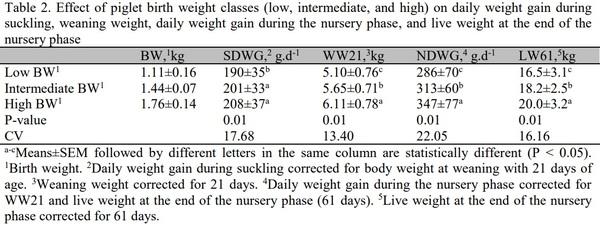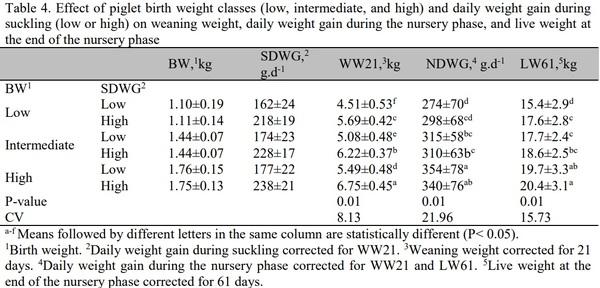INTRODUCTION
Several factors influence piglet performance after birth. In general, pig producers aim at heavy birth and weaning weights because they are associated with better performance during subsequent rearing phases. This association was first described in the 1980s by Powell and Aberle (1980) and has been recently studied and discussed in the literature. However, Surek et al. (2014), working with litters of 11 piglets each standardized by birth weight, observed that lighter piglets presented a lighter weaning weight, but had the same daily weight gain as heavier piglets during the suckling phase.
Sow milk production and milk intake by piglets determine their early performance. Harrell et al.(1993) verified that piglets fed an artificial diet grew, on average, 70% faster and were 53% heavier at 21 days of age when compared to those remaining with the sow, suggesting that sow milk production did not supply all the nutritional requirements of piglets. According to Boyd et al. (1995), a sow rearing 10 piglets up to 21 days old should produce 18–20kg of milk per day. However, modern hyperprolific sows can produce only 1kg of milk per piglet in litters with up to 14 piglets (Auldist et al., 1998). Therefore, piglets may experience nutritional restriction during suckling and consequently present a low daily weight gain. The genetic potential for daily weight gain can only be expressed if animals have access to the required amount of nutrients. Fraser and Morley Jones (1975) found that heavier piglets at birth and at three weeks of age tended to occupy the more productive teats, but this relation was considered weak due to the low correlation coefficient. Kim et al. (2000) observed in primiparous sows that piglets suckling anterior and middle teats presented a higher daily weight gain than those suckling posterior teats, but no preference of the heavy piglet for anterior teats was detected.
Therefore, the study of the relationship of body weight of pigs at different rearing phases and submitted to different environmental conditions and nutritional and non-nutritional strategies may allow the design of management practices to improve live performance, pig livability, and carcass quality. Therefore, the aim of this research was to study the relationship between the birth weight of piglets and daily weight gain during suckling with their daily weight gain during the nursery phase.
MATERIAL AND METHODS
The experiment was approved by the Committee of Ethics on Animal Use of the sector of Agricultural Sciences of the Federal University of Paraná, Curitiba, PR, Brazil, under protocol number 072. Historical data from a commercial farm located in the south of Brazil, state of Paraná, were analyzed between January and March 2009. Five hundred and thirty-four piglets born from 55 primiparous sows (Landrace x Large White) during the same week were evaluated. Piglet sex and individual birth weight (BW) were recorded. Approximately six hours after the placental expulsion, litters were standardized as a function of the number of functional teats. After litter standardization, piglets were submitted to teeth clipping and tail docking. Males were castrated at 5 days of age.
Sows were housed in individual farrowing crates (2.2 x 1.6m) on fully-slatted plastic floor and equipped with a 5-kg capacity concrete trough feeder and a cup drinker. A micro-pelleted diet was manually offered to the sows four times daily, at ad libitum allowance. Piglets were supplied with creep feed after 5 days of age. Room environment was controlled using sidecurtains. Piglet creep area was heated using incandescent lamps. All piglets were weighed at weaning in order to calculate the weaning weight adjusted for 21 days (WW21), according to Favero et al. (1992), and average daily weight gain during the suckling phase (SDWG). Weaning weight was adjusted to 21 days using the following linear regression equation: Y= Z – b (X – 21), where: Y= adjusted weight; Z = observed weight; b = coefficient of linear regression of weaning weight; and X = age at weaning.
At weaning, piglets were transferred to a nursery room, where they were maintained for 40 days. A four-phase feeding program was applied, consisting of three pre-starter diets (1, 2, and 3) and a starter diet. Pre-starter diet 1 was supplied during the suckling phase and first nursery week. Pre-starter diets 2 and 3 were pelleted and supplied during weeks 2 and 3 of the nursery period, respectively. Starter diet was pelleted and supplied during the last 19 days of the study. Diets were based on corn and soybean meal, and dairy products were gradually reduced until their total withdrawal in the starter diet. Sow and piglet diets were formulated to supply their nutritional requirements according to Rostagno et al. (2005).
All piglets were weighed at the end of the nursery phase in order to calculate the body weight adjusted for 61 days of age (LW61), according to Favero et al. (1992), and average daily weight gain during the nursery phase (NDWG). Nursery weight was adjusted to 61 days of age using the following linear regression equation: Y= Z – b (X – 61), where: Y = adjusted weight; Z = observed weight; b = coefficient of linear regression of nursery weight; and X = age at weighing. Piglets were classified for data analysis into three birth weight (BW) classes (by dividing the group into 1/3 low, 1/3 intermediate, and 1/3 high) and two pre-weaning performance classes (by dividing the group into 1/2 high or low daily weight gain during the suckling phase – SDWG), as follows: low BW and low SDWG piglets, low BW and high SDWG piglets, intermediate BW and low SDWG piglets, intermediate BW and high SDWG piglets, high BW and low SDWG piglets, and high BW and high SDWG piglets.
Performance data were analyzed according to a completely randomized experimental design. Initially, three treatments were evaluated (three birth weight classes), with 178 replicates (piglets) per treatment. Subsequently, six treatments were evaluated, consisting of three birth weight classes and two pre-weaning weight gain classes per birth weight, with 89 replicates (piglets) per treatment. Firstly, the data were submitted to the Shapiro-Wilk normality test. The data with normal distribution were analyzed using ANOVA. Means were compared by the Tukey’s test at 5% probability level. Correlations between treatments as a whole and a function of birth weight classes were analyzed by the Pearson method.
RESULTS
The average birth weight of the 534 piglets was 1.43kg, ranging between 0.60 and 2.30kg.
Weaning age ranged between 18 and 25 days, with an average of 21.3 days. The correlations among performance traits of the 534 piglets are shown in Table 1. All the analyzed traits (BW, WW21, SDWG, LW61, and NDWG) were positively correlated. BW and WW21 were highly correlated with LW61, and BW presented a higher correlation with NDWG than with SDWG.
Piglet performance results from birth to the end of the nursery phase per BW class are shown in Table 2. Low, intermediate, and high birth weight classes included piglets weighing 0.60 to 1.25, 1.25 to 1.50, and 1.50 to 2.30kg, respectively. The initial difference of 0.65kg between the average BW of piglets of low and high BW classes resulted in differences of 18g in SDWG, 1010 g in WW21, 61 g in NDWG, and 3500g in LW61 (Table 2).
Correlations among the evaluated parameters (BW, WW21, SDWG, LW61, and NDWG) as a function of BW class are shown in Table 3. There was no correlation between BW and SDWG for any of the BW classes. There was no correlation between BW and LW61 or between BW and NDWG in intermediate BW piglets. No correlations between WW21 and NDWG or between SDWG and NDWG were detected in piglets of intermediate and high BW classes, or between BW and WW21 in high BW piglets. The remaining correlations were positive and significant (Table 3).



The analysis of the effects of high and low SDWG, within BW classes (Tab. 4) demonstrated that high SDWG piglets presented higher WW21. Body weight difference in low BW and low SDWG piglets was 1.18kg at 21 days and increased to 2.20kg at the end of the nursery phase. Intermediate and high BW piglets presented weight differences of 1.14 and 1.26kg at weaning and 0.90 and 0.70kg at the end of the nursery phase, respectively. High BW and low SDWG piglets were 0.2kg lighter at weaning when compared with those with low BW and high SDWG. However, this situation was inverted at the end of the nursery phase, when high BW and low SDWG piglets were 2.10kg heavier when compared to those with low BW and high SDWG. In number of piglets from high BW and low SDWG groups, among the 89 animals, 48 piglets had a weaning weight below 5.69kg, which was the mean weaning weight of the low BW and high SDWG group. In addition, among these same 48 piglets, 29 animals at the end of the nursery phase exceeded 17.6kg of weight, which was the mean weight achieved by the low BW and high SDWG group.

DISCUSSION
The correlation between piglet birth weight and their subsequent performance has been extensively reported in the literature. Gondret et al. (2006), Beaulieu et al. (2010), and Fix et al. (2010) observed a positive correlation between birth weight and post-weaning weight gain and body weight, which continues up to market age. Surek et al. (2014) found that heavier piglets at birth were also heavier at weaning. However, these authors did not observe a correlation between birth weight and daily weight gain during suckling and attributed this result to the litter birth weight equalization.
Wolter et al. (2002), using litters standardized by birth weight and classified as light or heavy (1.3 vs. 1.8kg), obtained a 0.9-kg difference in weaning weight between birth weight classes, and the same difference in piglets fed or not a liquid supplement during suckling. In addition, supplementation during suckling increased piglet weight gain by 23%, but no effect of birth weight was detected. The authors also found that supplementation during lactation resulted in higher weaning weights for heavier piglets at birth and suggested that supplementation should only be provided to low birth weight piglets in order to obtain less variation in weaning weight.
When comparing the different BW classes in the present study, there was a low BW x WW21 correlation in intermediate BW piglets, and this correlation was not significant in high BW animals. Quiniou et al. (2002) performed a polynomial regression analysis of the relationship between birth weight and weaning weight and found that for each additional 100g in birth weight of piglets with approximately 1kg, there was a 400g increase in weaning weight, while in 2kg birth weight piglets, the increase in weaning weight was only 200g.
The data in Tables 1 and 2 show that low BW piglets continued to be lighter at weaning. However, when piglets are considered within birth weight classes, this relationship does not apply. The present study showed that low BW piglets might have presented higher weaning weight corrected for 21 days than those with high BW. The causes of this variation in SDWG were not evaluated once several factors can influence daily weight gain during suckling, such as genetics, colostrum and creep feed intake, differences in milk production among sows and teats, as well as health conditions. However, regardless of the causes, the results allow an interesting reflection on the growth behavior of piglets during the subsequent nursery phase.
The current results indicate a partial compensatory gain in the nursery by intermediate and high BW and low SDWG piglets. Fix et al. (2010) evaluated the performance of piglets removed or not from their biological dams and found an interaction between birth weight and piglet transference. The non-fostered heavy BW piglets presented higher daily weight gain during suckling and weaning weight when compared to fostered piglets. However, this interaction was not observed in subsequent phases. Fix et al. (2010) suggested that cross-fostered piglets were able to overcome their initial disadvantage.
Sarkar et al. (1983), working with the removal of piglets from dams at regular intervals in order to force feed restriction, found a 6.3kg difference in weaning weight (35 days) between the control and restricted-fed piglets, but this difference was only 6kg at 166 days of age. Wolter et al. (2002) did not find any interaction between birth weight and liquid supplementation of suckling piglets relative to their performance immediately after weaning or until they reach 25kg of live weight. However, between 14 and 25kg, light BW piglets not supplemented during suckling presented a higher feed efficiency and weight gain than other treatments (unsupplemented or supplemented vs. light or heavy). These authors suggested that further studies on the causes of this interaction are needed and observed a higher influence of birth weight on post-weaning performance and days to market than the supplementation during the suckling period. Miller et al. (2012) also did not observe any residual effect of feeding a liquid supplement to suckling piglets on postweaning body weight. However, caution should be taken when analyzing the effects of liquid supplementation of suckling piglets because, according to Azain et al. (1996) and Miller et al. (2012), its supply during suckling is more effective in the summer, promoting higher weaning weights. Therefore, the adoption of management practices aiming at feed restriction of piglets during suckling should be economically assessed, including their performance during the subsequent phases.
CONCLUSIONS
In conclusion, within the same birth weight class, the daily weight gain during the nursery phase of piglets with low weight gain during suckling was not different when compared to those with a high weight gain. Piglets with 1.25–2.30kg birth weight and low weight gain during suckling presented a partial compensatory growth, as shown by their body weight at the end of the nursery phase.
This article was originally published in Arq. Bras. Med. Vet. Zootec., v.71, n.6, p.2034-2040, 2019. https://doi.org/10.1590/1678-4162-10786. This is an Open Access article distributed under a Creative Commons Attribution License.














